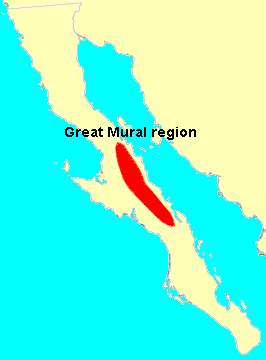Great Mural Rock Art facts for kids
Imagine ancient paintings, some bigger than a person, hidden in mountain caves! These are the Great Mural Rock Art paintings. You can find them on the walls and ceilings of natural rock shelters in the mountains of Baja California Sur and Baja California, Mexico. This amazing collection of art is so important that UNESCO has listed it as a World Heritage Site. It's part of the Rock Paintings of Sierra de San Francisco site.
What Makes Them Special?
These ancient rock art paintings can be either one color (monochrome) or many colors (polychrome). The artists most often used red and black. But you can also see white, pink, orange, and green in some paintings.
The most common pictures are humans and deer. But you'll also find many other animals. These include rabbits, bighorn sheep, birds, fish, and snakes. The human figures often have cool, fancy headdresses. Some of the human and animal pictures also show shapes that look like arrows or atlatl darts.
The pictures are mostly simple outlines, like silhouettes. They don't have tiny details inside. Instead, the artists used cool patterns like stripes or bands of different colors. For humans, turtles, birds, and most fish, they painted them as if you were looking straight at their front. But for deer and most other animals, they painted them from the side.
Sometimes, new paintings were made right over older ones. It's like a new artist painted on top of an old drawing. Some murals look like they were carefully planned with all the pictures arranged together. But in many cases, it seems like each figure was painted on its own, without much thought for other pictures nearby.
Where Are They Found?
The Great Murals are located in the mountain ranges of Guadalupe, San Francisco, San Juan, and San Borja. These areas are in the middle part of the Baja California peninsula. To the north and south, you'll find other types of rock art, but they are not as grand as the Great Murals. Even within the Great Mural area, there are other kinds of pictographs (rock paintings) and petroglyphs (rock carvings).
These murals are found in the land where the Cochimí people lived long ago. People often thought the Cochimí were the artists, especially since the murals are linked to the ancient Comondú complex. However, in the 1700s, the Cochimí told Jesuit missionaries that they didn't make the paintings. Recent studies using radiocarbon dating have shown that these Great Murals might be very, very old. Some could be as old as 7,500 years!
Who Studied Them?
The first people to notice the Great Murals were Jesuit missionaries, like José Mariano Rotea and Francisco Escalante, back in the 1700s. The first scientific studies began later, between 1889 and 1913, by a French scientist named Léon Diguet. In the early 1950s, Mexican journalist Fernando Jordan and archaeologists Barbro Dahlgren and Javier Romero also reported on these amazing sites.
The Great Murals became famous in the United States after a 1962 article in Life magazine. This article was written by the mystery writer Erle Stanley Gardner. Since then, many researchers have visited and studied these sites. For example, Eve Ewing has been studying the art for 50 years! She has made over a hundred trips to see the different paintings. Other important people who have studied these murals include Clement W. Meighan, Campbell Grant, Harry W. Crosby, Enrique Hambleton, Justin R. Hyland, and María de la Luz Gutiérrez.


